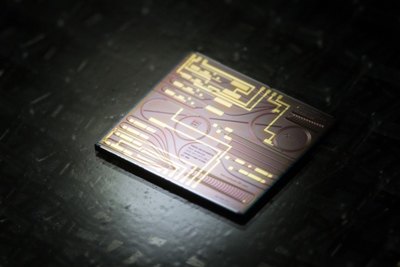New open access facility, backed with European regional development funding, is expected to help incubate new photonics SMEs.

PIC pilot
A dozen European partners are collaborating on a new €14 million pilot line to produce photonic integrated circuits (PICs).
With €8.3 million from the European Regional Development Fund, the “OIP4NWE” project partners held a kick-off meeting this week, in advance of installing key equipment and processes at Eindhoven University of Technology’s Photonic Integration Technology Center. Full operation is scheduled for 2022.
The multi-project wafer facility will involve close cooperation with Vrije Universiteit Brussel in nearby Belgium for front-end processing and light-coupling optics, and the Tyndall National Institute in Cork, Ireland, for assembly and packaging.
Raising TRL
The Eindhoven team says that the collaborative effort should “drastically” reduce costs and time for the pilot production, helping to create new companies that would otherwise be unable to afford to make PICs, and raising the technology readiness level (TRL) to commercial viability.
“One of the key problems photonics will help tackle is the exploding energy consumption of data centers, as photonic microchips consume much less energy than their electronic predecessors,” they predict. “Another example is a high-precision monitoring system for aircraft wings, bridges or tall buildings.”
Key goals include reducing defect levels in processed indium phosphide (InP) wafers, as well as speeding production throughput.
“All in all, this should lead to a cost reduction which significantly lowers the threshold for developing new photonic products,” say the optimistic Eindhoven coordinators. “This should help establish a thousand integrated photonics firms within ten years.”
Automation
Following installation of equipment from the likes of project partner and epitaxy tool vendor Aixtron, the second stage of the effort will focus on automation. A third stage will involve intensive industrial research in collaboration with more equipment manufacturers, to optimize and develop new processes.
“The line should be fully in operation in 2022,” predicts the team. “To incentivize the initial uptake by SMEs, a voucher scheme for external SMEs will be set up.”
Aside from Aixtron, industrial partners involved in the effort include three Netherlands-based companies, in the form of Smart Photonics, VTEC Lasers & Sensors, and Technobis Fibre Technologies.
Also involved are the photonics design company mBryonics, a spin-out from the National University of Ireland Galway’s applied optics research group, alongside UK-based equipment firm Oxford Instruments and a trio of research centers in France, Germany, and the Netherlands.
source:Optics.org




